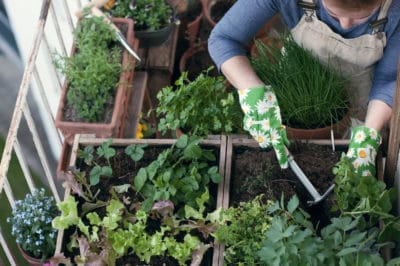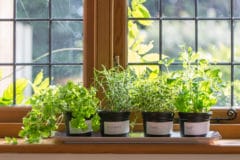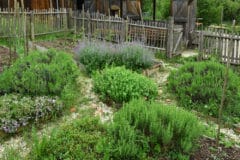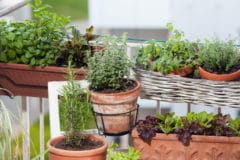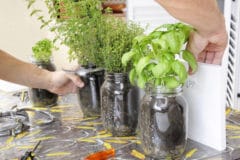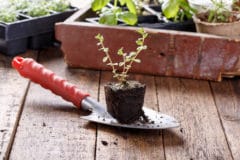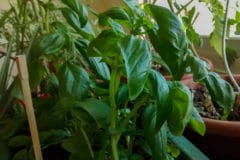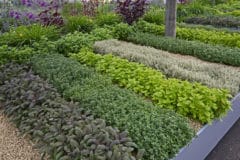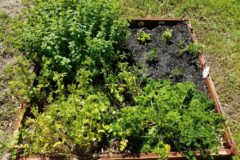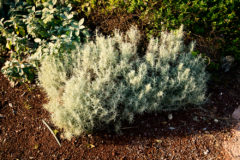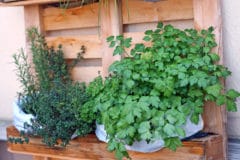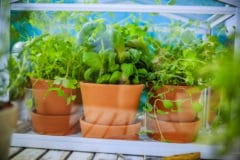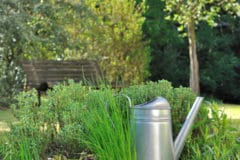The right Location
The majority of herbs prefer a sunny, warm and sheltered place. If the balcony garden is too draughty, guardrails or low protective hedges (e.g. from semi-shrubs such as lavender, sage or rue) can help. It is ideal if the safety barrier of the balcony is not made of solid stone, but of translucent glass / plastic or a grid. Some herbs also feel more at home in a semi-shade place. This is especially true for species that grow in forests or on the edge of forests – typical examples are wild garlic or woodruff.
The right earth
Herbs sometimes have very different demands on the soil in which they grow. You should always use sowing soil for cultivation and propagation; in most cases, sufficient fertilised potting soil is recommended for further cultivation. Mediterranean herbs such as rosemary, thyme or sage love dryness and need lean, permeable soil. In this case, sand is added to the potting soil. Herbs such as lemon balm or peppermint, on the other hand, love it more humid; for these plants you need a soil with a stable structure and little mould.
Selection of planters
Sufficiently large plant containers are also a very important prerequisite for the healthy growth of plants. These are available in different sizes, shapes and materials, whereby the size of the pots required can easily be derived from the expected size of the plant. As a rule of thumb, the root volume of a plant is hardly less than the corresponding above-ground plant parts. This means that you need a container with a diameter of approx. 20 centimetres for a plant growing to a height of 40 to 60 centimetres.
What’s better: natural materials or plastic?
Clay pots, wooden or ceramic vessels, baskets and balcony boxes are particularly suitable. When using plastic containers, you should make sure that the roots of the plants can be sufficiently ventilated. In order to avoid waterlogging harmful to the herbs, the containers must have sufficiently large drainage holes in the ground.
Ideas for the design of the pot garden
A pot herb garden on the balcony can be very versatile. Of particular interest here is a colourful mix of herbs, which are planted together in a balcony box or pocket pots or arranged in weatherproof wall shelves, for example. The herb pots are also well presented if you do not place them on one level, but on different floors. In contrast, a pot herb garden with green, silver or red-leaved species according to colour appears somewhat more formal. It can also be useful to sort according to the possible use – for example according to tea and aromatic herbs, edible leaves and flowers for decoration.
So is planted
The holes in the bottom of the pots are covered with pebbles or clay shards. Then fill half of the pots with soil and place the young plants in them. Now you can fill the vessels to the rim with soil and press well on them. Also push in a small pouring rim, through which the water is later fed directly to the roots. Don’t forget to water the freshly planted herbs vigorously – this makes it easier for the roots to grow.
The right Care of the pot garden
During the growth period the plants need water regularly. It makes sense to let the bale almost dry out and only then water it thoroughly. In this way, the roots are evenly supplied with water and air, and you can more easily prevent overwatering. About four weeks after potting, the herbs should be regularly fertilized with liquid fertilizer. Use special herbal fertilizers from the specialist trade, which you dose according to instructions, add to the watering water and usually apply once a week. Instead, you can also make your own vegetable broth from nettles, horsetail and / or comfrey. It contains nitrogen, potassium and many trace elements – but stinks quite a lot during production. However, you can alleviate the severe odour by adding rock flour, which also provides additional nutrients.
repot potted plants
Some herbs – such as basil – are only cultivated for one year. Repotting is of course not necessary here, instead you sow the offspring every year anew. However, plants such as lavender, rosemary or lemon bush, which remain in the same tub every year, need some fresh soil every year. For this purpose, the uppermost soil layer is replaced. If this is no longer possible or if the plant pot has become too small due to growth, you should repot the plant soon. Spring is the best time for this. The new vessel should have a diameter at least four centimetres larger than the old one.
potted herbs hibernate properly
Perennial, frost-sensitive herbs spend the winter best in the house. Frost-free, bright rooms such as the staircase, a winter garden or a suitable cellar are suitable for this purpose. If, on the other hand, pots with sensitive herbs are to be wintered on the balcony, they must be packed well and placed against the heat-radiating house wall and on wooden blocks or a polystyrene base.
Hint
Only plant herbs together in a plant container that have similar requirements for sun, water and nutrients.
